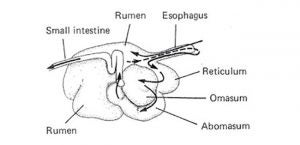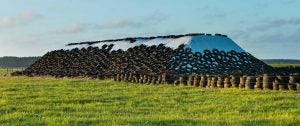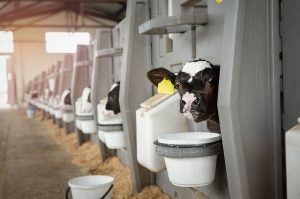Did you know dairy cows have their own nutritionists?
These animal nutritionists are the sports nutritionists of dairy farming. They make sure that the cows, like athletes, are eating right. A balanced diet is important for humans and cows alike.
Dairy farmers work with dairy cattle nutritionists to design and balance the diet their cows receive. They make sure the cows are getting the nutrients they need in the correct amounts. This minimizes any leftover feed and maximizes the nutrients that cows are receiving. All of this is to ensure happy, healthy, and productive cows.
Here is a high-level look at what goes into it:
Ruminant digestion
Dairy cattle are unique in that they’re ruminants. This means that they have a four-chambered stomach (not four separate stomachs). The largest compartment — the rumen — is like a giant fermentation vat, which contains microbes that digest the feed and produce energy and protein for the cow.

Keeping the microbes happy allows them to effectively break down fiber, which keeps the cow healthy. This fiber digesting ability allows cows to convert hay and other fibrous forages into milk, for us to enjoy.
The other chambers — reticulum, omasum, and abomasum — also serve vital functions, and to get a deep dive on how they all work (and work together!), I encourage you to see this article from an animal scientist and rancher.
What do dairy cows eat?
Dairy cattle diets vary a lot by region. The majority of a dairy cow’s diet is made up of forages, which are fibrous feeds such as corn silage (chopped fermented whole corn plants), legumes (ex. Alfalfa, clover, vetch, etc.), and grasses. The rest of the diet includes feeds such as corn, soybeans, byproduct feeds, vitamins, and minerals.

Byproduct feeds are recycled from the leftovers from other industries and help to reduce food waste. These include canola meal, candy meal, cottonseed meal, corn gluten feed (leftovers from ethanol production), brewers’ grains, soybean meal, and many others which vary by region and availability. Citrus pulp is common in Florida as a by-product of the citrus industry. Almond hulls are common in California, from the extensive almond industry there.
Check out this post about byproduct feeds.
Dairy nutrition is a science
Feeding a dairy cow is a lot more complicated than just throwing hay in front of a cow to get milk. There’s a lot of science, innovation, and research behind it. Dairy Cattle Nutritionists typically need a master’s degree or a doctorate in their field, because of the amount of knowledge and experience needed. Technology has advanced all around us, and dairy cattle nutrition is no exception.
Nutritionists consider the possible feed ingredients for meeting the nutritional needs of the cow. The nutritional needs also change with weather and other factors such as milk production level and pregnancy status.

The feed also needs to be palatable to the cows and make sense for what feeds are available and affordable for the farmer to either grow themselves or purchase. It all needs to be measured out correctly and mixed. This mixture called a Total Mixed Ration (TMR) is like a cow trail mix, which meets the nutritional needs of each cow with every bite. With over 30 different nutrition requirements, cows often eat better than people!
TDF Honest Farming explains TMR mixing in this video.
Dairy cattle nutritionists play an integral role on dairy farms. They work with farmers to keep their cows happy, healthy, and productive. They also play a key role in sustainability with the effective utilization of byproduct feeds and precision feeding systems.
Michelle Miller, the Farm Babe, is a farmer, public speaker, and writer who has worked for years with row crops, beef cattle, and sheep. She believes education is key in bridging the gap between farmers and consumers.



